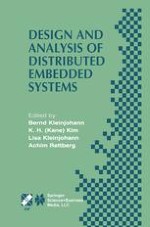2002 | Buch
Design and Analysis of Distributed Embedded Systems
IFIP 17th World Computer Congress — TC10 Stream on Distributed and Parallel Embedded Systems (DIPES 2002) August 25–29, 2002, Montréal, Québec, Canada
herausgegeben von: Bernd Kleinjohann, K. H. Kim, Lisa Kleinjohann, Achim Rettberg
Verlag: Springer US
Buchreihe : IFIP Advances in Information and Communication Technology
Enthalten in: Professional Book Archive
